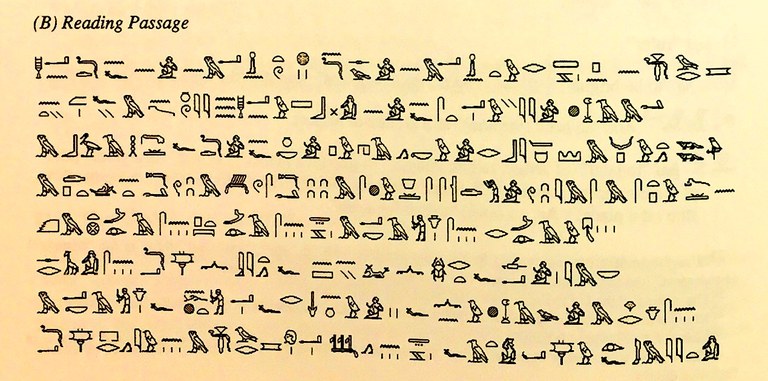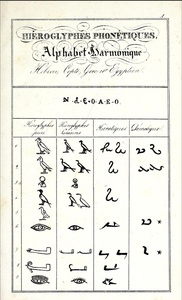Getting Started with... Middle Egyptian
Middle Egyptian, sometimes referred to as Classical Egyptian, refers to the language spoken at Egypt from the beginning of the second millennium BCE to roughly 1300 BCE, or midway through the New Kingdom. It is also the written, hieroglyphic language of this period and so the medium in which the classical Egyptian literature of this period is transmitted. Funerary inscriptions, wisdom texts, heroic narratives like the “Tale of Sinuhe” or the “Shipwrecked Sailor,” and religious hymns have all come down to us in Middle Egyptian hieroglyphic. We also have papyri from this period written in a cursive script known as hieratic. The “middle” separates this phase of the Egyptian language from that of the previous millennium, or Old Egyptian (for example, the “pyramid” texts), and Late Egyptian, which begins in the second half of the New Kingdom and lasts until roughly 700 BCE with the emergence of Demotic.
Like many New Yorkers, I remember my curiosity about Egyptian being piqued at an early age by a trip to the Metropolitan Museum of Art and seeing, for example, the hieroglyphic inscriptions in the reliefs. When I heard that ISAW Assistant Director for Academic Affairs, Marc LeBlanc, was teaching a directed reading in Middle Egyptian this fall, I wondered how a curious student would go about getting a handle on the language. I sat down recently with LeBlanc, who earned his doctorate in Egyptology from Yale, to discuss learning Middle Egyptian. Here are his recommendations for someone curious about getting started with Middle Egyptian, including textbooks, grammars, lexica, and other resources, and where you can find them at ISAW.

LeBlanc got his start in Middle Egyptian with J. E. Hoch’s Middle Egyptian Grammar [Benben; Large PJ1135. H63 1997], but his recommendation for a newcomer to the language is J. P. Allen’s Middle Egyptian: An Introduction to the Language and Culture of Hieroglyphs [Cambridge; Reference 4 PJ1135 .A45 2014]. Allen writes his book for “those who want to be able to read the texts for themselves, to understand the inscriptions on monuments in Egypt or in museums, or simply to learn a fascinating ancient language for its own sake.” The results are impressive: 26 chapters packed with grammar lessons, sign and vocabulary lists, exercises, and essays offering linguistic, cultural, historical, and religious context for the material. Both Hoch and Allen include a glossary and a key to the exercises—a sure help for self-teaching. Allen also includes two helpful lists of hieroglyphic signs, one organized thematically and the other by shape. Lastly, Allen provides a substantial index of works from which lesson examples and exercises are drawn. The advantages to the student seeing the direct line from, say, relative clauses to their appearance in the Sayings of Ptahhotep are clear. For autodidacts, LeBlanc also recommends M. Collier and B. Manley’s How to Read Egyptian Hieroglyphs: A Step-by-step Guide to Teach Yourself [U. of California Press; NYU PJ1097 .C65 1998b], a culture-first approach to the language that teaches the language though the monuments and inscriptions now in the British Museum.
As you progress with Middle Egyptian, LeBlanc suggests having a few other resources at your disposal. A. H. Gardiner’s Egyptian Grammar: Being an Introduction to the Study of Hieroglyphs [Griffiths Institute; Large PJ1135 .G3 1976] is a defining work in the field. A complete descriptive grammar of Middle Egyptian, the book also includes vocabularies, exercises (an in particular a substantial number of English-to-Egyptian translation exercises), and perhaps most significantly, Gardiner’s “List of Hieroglyphic Signs.” Worth noting here as well is J. F. Borghout’s Egyptian: An Introduction to the Writing and Language of the Middle Kingdom [Peeters; Large PJ1135 .B674 2010]. Ostensibly an introductory book, it bills itself as a “data-oriented grammatical description” of the language, and that it is: perhaps a bit too detailed and technical in nature for a beginner, but for the student who has worked her way through the books mentioned above, it can illuminate some of the language’s more challenging aspects.
You will of course want a good dictionary as you work through the language. LeBlanc recommends R. O. Faulkner’s A Concise Dictionary of Middle Egyptian [Griffith Institute; Small PJ1425 .F3 1996], a hand-drawn/lettered English-to-Middle Egyptian lexicon that has been cross-referenced to textual or bibliographical sources. In his introduction, Faulkner writes that the book is “addressed primarily to the younger practitioners to Egyptology.” Accordingly, the book is designed to offer students a portable reference work that is both comprehensive and basic: “In order to attain maximum compression, the meanings given do not attempt to indicate the finer nuances, but generally are on broad lines.” Where necessary, more detail can be found in R. Hannig’s Grosses Handwörterbuch Ägyptisch-Deutsch: die Sprache der Pharaonen (2800-950 v.Chr.) [P. Von Zabern; Small PJ1430 .H36 1997].

The textbooks and grammars listed above include a substantial amount of primary material, both transliterated and in hieroglyphic, and should suffice for getting the introductory student started with authentic Middle Egyptian texts. But ambitious students who wish to proceed to readers with longer selections, LeBlanc recommends the following: K. Sethe’s Ägyptische Lesestücke zum Gebrauch im akademischen Unterricht: Texte der mittleren Reiches [G. Olms; IFA PJ1141 .S4] and A. de Buck’s Egyptian Readingbook: Exercises and Middle Egyptian Texts [Ares; Large PJ1143 .B83 1982].
Students looking for Middle Egyptian reading material in translation have several good options, including M. Lichtheim’s three-volume Ancient Egyptian Literature: A Book of Readings [U. of California Press; Small PJ1943 .A52 1973] and W. K. Simpson’s The Literature of Ancient Egypt: An Anthology of Stories, Instructions, Stelae, Autobiographies, and Poetry [Yale University Press; Small PJ1943 .L57 2003a]. Volume 1 of Lichtheim’s anthology includes literature from the Middle Kingdom, including monumental inscriptions, didactic literature, songs, hymns, and prose narratives. Simpson’s collection covers similar ground but, with the release of its third edition, has the advantage of more up-to-date translations and an expansive bibliography. (Speaking of bibliography, NYU has access to Oxford’s comprehensive Online Egyptological Bibliography.) Lastly, for anybody looking to get a quick survey of Egyptian literature, Penguin Classics has recently released a handy anthology edited by T. A. H. Wilkinson called Writings from Ancient Egypt [Penguin; NYU PJ1943 .W75 2016] and the Oxford World Classics series has The Tale of Sinuhe and other Ancient Egyptian Poems, 1940-1640 BC [Oxford University Press; NYU PJ1945 .T35 1997] edited by R. B. Parkinson.
There is a great deal of public-domain Egyptological books online: for example, M. Champollion’s field-defining work—Précis du Système Hiéroglyphique des Anciens Égyptiens from 1824—can be found in the Internet Archive. But, as Lichtheim wrote in her introduction to 1971’s Ancient Egyptian Literature, “Egyptology, being a young science, is in a state of rapid growth and change.” The same remains true today and LeBlanc notes that so much progress has been made in Egyptology and in the decipherment and interpretation of the language, not just in the last century, but in the last decade, that public-domain works found in the Internet Archive or HathiTrust, such as E. A. W. Budge’s substantial output from the late 19th and early 20th century—should be approached with caution.
Finally, there are a growing number of useful digital resources for learning Middle Egyptian. For example, the Berlin-Brandenburgische Akademie der Wissenschaften’s Thesaurus Linguae Aegypticae project (registration required) provides students of the Ancient Egyptian language with a digital lexicon (based on A. Erman’s landmark Wörterbuch der ägyptischen Sprache [Akademie-Verlag; Oversize PJ1430 .E67 1982]) and an extensive corpus of annotated texts and translations. The Digital Egypt for Universities site hosted by University College London and the Petrie Museum offers a wide range of resources covering the archaeology, history, material culture, and literature of Ancient Egypt, and a student of Middle Egyptian should find the the transliterations, translations, and notes helpful in the section on “Egyptian Literary Compositions of the Middle Kingdom and Second Intermediate Period.” For students interested in working directly with the hieroglyphic script, Serge Rosmorduc has produced JSesh, a free and open-source word processor for ancient Egyptian hieroglyphic texts.
Students of Middle Egyptian will undoubtedly want to supplement their language learning with further reading about its historical and cultural context. In this respect, the essays in Allen’s Middle Egyptian (see above) already provide the language student with an excellent start. Beginners looking for a historical overview should find I. Shaw’s The Oxford History of Ancient Egypt [Oxford University Press; Small DT83 .O946 2003] helpful. For information on the development of the language itself, LeBlanc recommends A. Loprieno’s Ancient Egyptian: A Linguistic Introduction [Cambridge University Press; NYU PJ1111 .L66 1995, also available online], a book the author describes as a counterbalance to Egyptology’s traditional philological approaches with a considerations of the “mechanisms of linguistic change inherent in the history” of the language.
Thank you to Emily Cole, Ogden Goelet, and Amber Jacob for their suggestions on this post.

